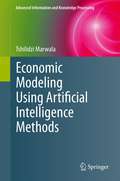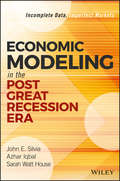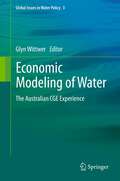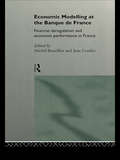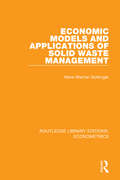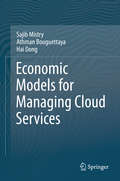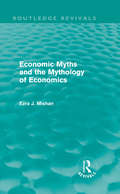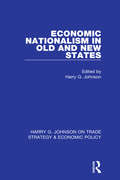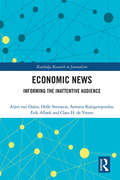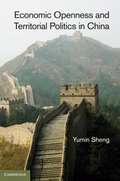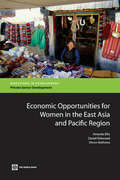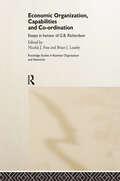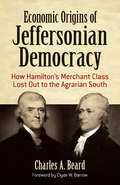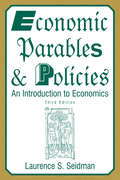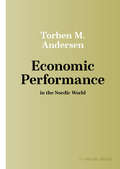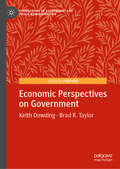- Table View
- List View
Economic Modeling Using Artificial Intelligence Methods
by Tshilidzi MarwalaEconomic Modeling Using Artificial Intelligence Methods examines the application of artificial intelligence methods to model economic data. Traditionally, economic modeling has been modeled in the linear domain where the principles of superposition are valid. The application of artificial intelligence for economic modeling allows for a flexible multi-order non-linear modeling. In addition, game theory has largely been applied in economic modeling. However, the inherent limitation of game theory when dealing with many player games encourages the use of multi-agent systems for modeling economic phenomena. The artificial intelligence techniques used to model economic data include: multi-layer perceptron neural networksradial basis functionssupport vector machinesrough setsgenetic algorithmparticle swarm optimizationsimulated annealingmulti-agent systemincremental learningfuzzy networksSignal processing techniques are explored to analyze economic data, and these techniques are the time domain methods, time-frequency domain methods and fractals dimension approaches. Interesting economic problems such as causality versus correlation, simulating the stock market, modeling and controling inflation, option pricing, modeling economic growth as well as portfolio optimization are examined. The relationship between economic dependency and interstate conflict is explored, and knowledge on how economics is useful to foster peace - and vice versa - is investigated. Economic Modeling Using Artificial Intelligence Methods deals with the issue of causality in the non-linear domain and applies the automatic relevance determination, the evidence framework, Bayesian approach and Granger causality to understand causality and correlation. Economic Modeling Using Artificial Intelligence Methods makes an important contribution to the area of econometrics, and is a valuable source of reference for graduate students, researchers and financial practitioners.
Economic Modeling in the Post Great Recession Era: Incomplete Data, Imperfect Markets
by Azhar Iqbal John E. Silvia Sarah Watt HouseReality-based modeling for today's unique economic recovery Economic Modeling in the Post Great Recession Era presents a more realistic approach to modeling, using direct statistical applications to address the characteristics and trends central to current market behaviors. This book's unique focus on the reality of today's markets makes it an invaluable resource for students and practitioners seeking a comprehensive guide to more accurate forecasting. While most books treat the economy as if it were in a vacuum, building models around idealized or perception-biased behaviors, this book deals with the economy as it currently stands—in a state of recovery, limited by financial constraints, imperfect information, and lags and disparities in price movements. The authors identify how these characteristics impact various markets' behaviors, and quantify those behaviors using SAS as the primary statistical tool. Today's economy bears a number of unique attributes that usual modeling methods fail to consider. This book describes how to approach modeling based on real-world, observable data in order to make better-informed decisions in toady's markets. Discover the three economic characteristics with the greatest impact on various markets Create economic models that mirror the current post-recession reality Adopt statistical methods that identify and adapt to structural breaks and lags Factor real-world imperfections into modeling for more accurate forecasting The past few years have shown a clear demarcation between policymakers' forecasts and actual outcomes. As the dust settles on the Great Recession, after-effects linger—and impact our current recovery in ways that diverge from past experience and theoretical expectations. Economic Modeling in the Post Great Recession Era provides comprehensive guidance grounded in reality for today's economic decision-makers.
Economic Modeling of Water: The Australian CGE Experience
by Glyn WittwerThe book details the innovative TERM (The Enormous Regional Model) approach to regional and national economic modeling, and explains the conversion from a comparative-static to a dynamic model. It moves on to an adaptation of TERM to water policy, including the additional theoretical and database requirements of the dynamic TERM-H2O model. In particular, it examines the contrasting economic impacts of water buyback policy and recurring droughts in the Murray-Darling Basin. South-east Queensland, where climate uncertainty has been borne out by record-breaking drought and the worst floods in living memory, provides a chapter-length case study. The exploration of the policy background and implications of TERM's dynamic modeling will provide food for thought in policy making circles worldwide, where there is a pressing need for solutions to similarly intractable problems in water management.
Economic Modelling at the Banque de France: Financial Deregulation and Economic Development in France (Routledge New International Studies in Economic Modelling #No.3)
by Michel Boutillier Jean CordierEconomists at the Bank of France analyse causes and consequences of French monetary policy and financial deregulation during the 1980s. Using the latest econometric techniques, they demonstrate a strategy that the UK is still hesitating to fully adopt. These essays, never published in English before, offer a comprehensive and authoritative analysis.
Economic Models and Applications of Solid Waste Management (Routledge Library Editions: Econometrics #6)
by Hans-Werner GottingerOriginally published in 1991. The dilemma of solid and hazardous waste disposal in an environmentally safe manner has become a global problem. This book presents a modern approach to economic and operations research modelling in urban and regional waste management with an international perspective. Location and space economics are discussed along with transportation, technology, health hazards, capacity levels, political realities and the linkage with general global economic systems. The algorithms and models developed are then applied to two major cities in the world by way of case study example of the use of these systems.
Economic Models for Managing Cloud Services
by Athman Bouguettaya Sajib Mistry Hai DongThe authors introduce both the quantitative and qualitative economic models as optimization tools for the selection of long-term cloud service requests. The economic models fit almost intuitively in the way business is usually done and maximize the profit of a cloud provider for a long-term period. The authors propose a new multivariate Hidden Markov and Autoregressive Integrated Moving Average (HMM-ARIMA) model to predict various patterns of runtime resource utilization. A heuristic-based Integer Linear Programming (ILP) optimization approach is developed to maximize the runtime resource utilization. It deploys a Dynamic Bayesian Network (DBN) to model the dynamic pricing and long-term operating cost. A new Hybrid Adaptive Genetic Algorithm (HAGA) is proposed that optimizes a non-linear profit function periodically to address the stochastic arrival of requests. Next, the authors explore the Temporal Conditional Preference Network (TempCP-Net) as the qualitative economic model to represent the high-level IaaS business strategies. The temporal qualitative preferences are indexed in a multidimensional k-d tree to efficiently compute the preference ranking at runtime. A three-dimensional Q-learning approach is developed to find an optimal qualitative composition using statistical analysis on historical request patterns. Finally, the authors propose a new multivariate approach to predict future Quality of Service (QoS) performances of peer service providers to efficiently configure a TempCP-Net. It discusses the experimental results and evaluates the efficiency of the proposed composition framework using Google Cluster data, real-world QoS data, and synthetic data. It also explores the significance of the proposed approach in creating an economically viable and stable cloud market. This book can be utilized as a useful reference to anyone who is interested in theory, practice, and application of economic models in cloud computing. This book will be an invaluable guide for small and medium entrepreneurs who have invested or plan to invest in cloud infrastructures and services. Overall, this book is suitable for a wide audience that includes students, researchers, and practitioners studying or working in service-oriented computing and cloud computing.
Economic Models for Policy Making: Principles and Designs Revisited (Routledge Frontiers of Political Economy)
by Solomon CohenOver the past decades, many different kinds of models have been developed that have been of use to policy makers, but until now the different approaches have not been brought together with a view to enhancing the systematic unification and evaluation of these models. This new volume aims to fill this gap by bringing together four decades’ worth of work by S. I. Cohen on economic modelling for policy making. Work on older models has been rewritten and brought fully up to date, and these older models have therefore been brought back to the fore, both to assess how they influenced more recent models and to see how they could be used today. The focus of the book is on models for development policies in developing economies, but there are some chapters that relate to economic policies in transition and developed economies. The policy areas covered are of typical interest in developing and transition economies. They include those relating to trade liberalization reforms, sustainable development, industrial development, agrarian reform, growth and distribution, human resource development and education, public goods and income transfers. Each chapter contains a brief assessment of the empirical literature on the economic effects of the policy measures discussed in the chapter. The book presents a platform of economic modelling that can serve as a refresher for practising professionals, as well as a reference companion for graduates engaging in economic modelling and policy preparations.
Economic Myths and the Mythology of Economics (Routledge Revivals)
by E. J. MishanFirst published in 1986, Economic Myths and the Mythology of Economics is a polemical study in which the author focuses on the popular myths and misconceptions that colour our understanding of economic issues. Professor Mishan, the internationally recognised economist and expert in the field of resource allocation and cost benefit analysis, undermines the idea that economics is a science. But such are popular myths, he argues, that governments employ battalions of economists in their ongoing attempts to promote economic growth, efficiency and employment. The author challenges the validity and measurement of such concepts as economic efficiency and GNP, and questions the assumption that free competitive markets can operate effectively in a rapidly changing, high-technology society. Professor Mishan foresees in his study further expansion as an unavoidable consequence of continued innovation, while revealing the interconnecting processes by which innovative activity, designed to raise living standards, has begun to erode the moral and psychological foundations of a viable and libertarian society.
Economic Nationalism And Development: Central And Eastern Europe Between The Two World Wars
by Jan KofmanIn art era of ever-increasing national consciousness combined, paradoxically, with pressures for regional economic integration, this thought-provoking and exhaustively researched volume will challenge readers' assumptions about optimal paths to national economic development. Drawing on archival sources as well as published materials in eight langua
Economic Nationalism in Old and New States (Harry G. Johnson on Trade Strategy & Economic Policy #2)
by Harry G. JohnsonOriginally published in 1968, this book brings together contributions from social scientists in anthropology, economic history, economics and political science in an exploration of the nature and effects of economic nationalism. The opening essays presents a formal theory of nationalism that relates the phenomenon to rational government processes. Following chapters explore whether nationalism and economic development went together and whether nationalistic economic polices actually promoted development. How far British economic policy was influence by nationalism, or its corollary for a successful country-imperialism is also assessed. Examples from China, Mali, Mexico and Canada are included.
Economic News: Informing The Inattentive Audience (Routledge Research in Journalism)
by Erik Albæk Arjen van Dalen Helle Svensson Antonis Kalogeropoulos Claes H. de VreeseThis book tells the story of how the news media can help the inattentive members of the public become better educated and knowledgeable ‘economic citizens’. The authors argue that changes in the economy, journalism and consumer culture have made economic news more visible, more mainstream and more accessible. They show how economic news not only affects economic perceptions, but also interest in the economy, knowledge about the economy, and economic voting. Relying on statistical analyses, the book provides a comprehensive and systematic study of the effects of economic news.
Economic Normalization With Cuba: A Roadmap For Us Policymakers
by Gary Clyde Hufbauer Barbara KotschwarGary Clyde Hufbauer, Reginald Jones Senior Fellow at the Peterson Institute for International Economics since 1992, was the Maurice Creenberg Chair and Director of Studies at the Council on Foreign Relations [1996-98), the Marcus Wallenberg Professor of International Finance Diplomacy at Georgetown University (1985-92), senior fellow at the Institute (1981-85), deputy director of the International Law Institute at Georgetown University 0979-81), deputy assistant secretary for international trade and investment policy of the US Treasury (1977-79), and director of the international tax staff at the Treasury (1974-76). Among his numerous coauthored books are Local Content Requirements: A Global Problem (2013), The United States Should Establish Permanent Normal Trade Relations with Russia (2012), Figuring Out the Doha Round [2010], and Economic Sanctions Reconsidered, 3rd edition (2007). Book jacket.
Economic Normalization with Cuba: A Roadmap for US Policymakers (Policy Analyses in International Economics #103)
by Gary Clyde Hufbauer Barbara KotschwarWill the Obama administration's decision to normalize relations with Cuba usher in a new era of economic cooperation, trade, and investment between the two countries? This prescient book, published only eight months before President Obama's historic announcement at the end of 2014, provides answers to that question and offers a roadmap for a sequenced lifting of the Cold War era economic sanctions against Cuba. Gary Clyde Hufbauer and Barbara Kotschwar lay out the difficulties of achieving a dynamic economic relationship. They caution that a unilateral dismantling of US sanctions without insuring that proper institutions are in place in Cuba could squander this golden opportunity for US companies and hurt Cubans. They argue that US policies should encourage Cuba to liberalize its economy and adopt democratic institutions, so that it does not transition from a Communist dictatorship to a corrupt and authoritarian oligarchy. This farsighted book, produced in anticipation of an opening with Cuba that seemed impossible to some skeptics, is a must-read for anyone interested in the evolution of a historically contentious relationship that promises to evolve productively if the right policies are pursued.
Economic Objects and the Objects of Economics
by László Zsolnai Peter RónaThis book examines the nature of economic objects that form the subject matter of economics, and studies how they resemble or differ from the objects studied by the natural sciences. It explores the question of whether economic objects created by modern economics sufficiently represent economic reality, and confronts the question whether tools, techniques and the methodology borrowed from the natural sciences are appropriate for the analysis of economic reality. It demonstrates the unsustainability of rational choice theory. It looks at economic agents, such as individuals, groups, legally constituted entities, algorithms, or robots, how they function and how they are represented in economics. The volume further examines the extent, if any, that mathematics can represent the objects of the economy, such as supply and demand, equilibrium, marginal utility, or the money supply as they actually occur in the economy, and as they are represented in economics. Finally, the volume explores whether the subject matter of economics – however defined – is the proper subject of theoretical knowledge, whether economics is an analytic or a descriptive discipline, or if it is more properly seen in the domain of practical reason. Specifically, the book looks at the importance and the ambiguity of the ontology of modern economics, temporality, reflexivity, the question of incommensurability, and their implications for economic policy.
Economic Openness and Territorial Politics in China
by Yumin ShengWhy and how has the Chinese central government so far managed to fend off the centrifugal forces under rising globalization that are predicted to undermine national-level political authority everywhere? When institutionally empowered by centralized governing political parties as in China, national politicians confronting the menace of economic openness will resort to exercising tighter political control over the subnational governments of the "winner" regions in the global markets. Although its goal is to facilitate revenue extraction, redress domestic economic disparity, and prolong the rule of national leaders, regionally targeted central political control could engender mixed economic consequences at the subnational level. Yumin Sheng examines the political response of the Chinese central government, via the ruling Chinese Communist Party, to the territorial challenges of the country's embrace of the world markets, and the impact of the regionally selective exercise of political control on central fiscal extraction and provincial economic growth during the 1978-2005 period.
Economic Opportunities for Women in the East Asia and Pacific Region
by Amanda Ellis Daniel Kirkwood Dhruv MalhotraThe East Asia and Pacific region has made great progress, relative to other regions, with regard to both economic development and, specifically, economic opportunities for women. However, aspiring female entrepreneurs continue to face unequal barriers to starting, operating, and growing their businesses. Not only does this hurt business women in the region, but it also ultimately hurts poverty reduction and economic growth. 'Economic Opportunities for Women in the East Asia and the Pacific Region' brings together data and available evidence on the constraints that female entrepreneurs in the region face with regard to: access to assets, business regulations and governance issues, and available avenues for expanding businesses and trading with larger markets. The authors present recommendations at the end of each chapter. This book will be of interest to policy makers, donors, nongovernmental organizations, and researchers looking to further examine the constraints that are holding back female entrepreneurs in East Asia and the Pacific.
Economic Organization of the British Coal Industry (Routledge Revivals)
by Andrew Martin NeumanEconomic Organization of the British Coal Industry (1934) is a study that shows on the one hand the organization of the coal industry in Britain in the 1930s in conjunction with the economic forces working behind the industry, and on the other hand shows the influence of political, authoritarian thought on its structure.
Economic Organization, Capabilities and Coordination (Routledge Studies in Business Organizations and Networks)
by Nicolai J. Foss Brian J. LoasbyThe work of G.B. Richardson has given insights into key issues and debates such as markets versus hierarchies, price stability, the economics of information and the concept of competition based upon differentiated firms.This collection encourages further development of Richardson's themes. It will make excellent reading for students looking at the capability or competence approach to the firm, and for all those wishing to familiarise themselves with the work of this important economist.
Economic Origins of Dictatorship and Democracy
by Daron Acemoglu James A. RobinsonThis book develops a framework for analyzing the creation and consolidation of democracy.
Economic Origins of Jeffersonian Democracy: How Hamilton's Merchant Class Lost Out to the Agrarian South
by Charles A. Beard Prof. Clyde W. BarrowThe sequel to the bestselling An Economic Interpretation of the Constitution, this volume focuses on the nation's early political history from the adoption of the Constitution through the end of the Jefferson administration. This period saw the rise and triumph of Jefferson's agrarian, slave-holding South over the mercantile-oriented urbanism of Hamilton's North, setting the stage for the ongoing clash between rural and urban America, a topic still highly relevant in the twenty-first century. Beard defines the early period of American governance in terms of the conflict between agrarianism and fluid capital that dominated the campaign for the ratification of the Constitution. He traces this dispute across three decades into its manifestations as Federalism versus Republicanism and later into Federalism and Jeffersonian Democracy. Broad in scope, Beard's view places the struggles within the context of social and cultural developments, and his interpretation provides an excellent resource for students of the historical background of American politics.
Economic Parables and Policies: An Introduction to Economics
by Laurence S. SeidmanThis work includes sections on combating recessions and the free market, as well as updated material on the pros and cons of establishing new individual accounts under Social Security. It also includes a discussion of the tax-credit approach to encourage the purchase of health insurance.
Economic Performance in the Middle East and North Africa: Institutions, Corruption and Reform (Routledge Political Economy of the Middle East and North Africa)
by Serdar SayanThe economies of the Middle East and North Africa (MENA) region are in dire need of substantial institutional reform to improve their growth performance so as to create enough jobs for millions of entrants into their respective job markets, and to fight poverty and income inequality. This is necessary not only to reduce the risk of social unrest and domestic/regional conflicts, but also to assure stability of energy supply to the rest of the world and to hamper the violence originating from the region. So, the region's convergence to global standards of governance quality is desirable for increased prosperity and stability both in the region and outside. This volume contributes to the recently burgeoning political economy literature on institutions by putting together well-written chapters that empirically study the relationship between economic performance and institutional characteristics in MENA economies to point out some of the areas where institutional reform is particularly needed and possible tools to use for such reform. Perhaps one common lesson that can be derived from all chapters in the volume is that the both the region itself and the global economy will benefit from a MENA region that is better integrated to the rest.
Economic Performance in the Nordic World (Nordic World)
by Torben M. AndersenThe Nordic countries stand out in international comparisons for having both high living standards and low inequality. The welfare state and public sectors are large and the tax burden is high. How have these countries managed to achieve such favorable economic performance? Economist Torben M. Andersen shows how the Nordic model rests on two pillars: the social safety net, which offers income compensation to the majority of those unable to support themselves, and the provision of services like education, childcare, and healthcare to all. The Nordic model can be characterized as one of employment, since its financial viability rests on a high labor participation rate with few working poor. Andersen lays out the structure of the model and highlights factors important for understanding its economic performance. He then looks into specific policy areas based on Denmark's experiences regarding labor market policies (flexicurity), pension systems, and preparation for an aging population; and addresses the challenges arising from new technologies and globalization.
Economic Perspectives on Government (Foundations of Government and Public Administration)
by Keith Dowding Brad R. Taylor“Dowding and Taylor offer student and scholar alike a clear and compelling perspective on the foundations of political economy. Their narrative coherently frames the scholarship of the last half century, and persuasively applies it to the recurring problems facing groups, markets, and whole societies.”—Kenneth A. Shepsle, Harvard University, USAThis book introduces and applies the economic way of thinking to public policy and public administration. It provides a non-technical introduction and assumes no prior economic or mathematical training but looks closely at the methodological and normative assumptions underlying economic analysis. It provides a deep understanding of the method than a simple technical presentation would allow. After introducing the basic assumptions of the economic method, the book considers the analysis of market failure, the role of government in a market economy, behavioural economics, bargaining in government, bureaucracy, interest groups, and levels of government. By providing a balanced introduction to and overview of economic approaches to government, the book will be useful to undergraduate and postgraduate students in public administration and public policy, as well as academics and practitioners in these fields interested in the application of the economic way of thinking.
Economic Persuasions
by Stephen GudemanAs the transition from socialism to a market economy gathered speed in the early 1990s, many people proclaimed the final success of capitalism as a practice and neoliberal economics as its accompanying science. But with the uneven achievements of the "transition"--the deepening problems of "development," persistent unemployment, the widening of the wealth gap, and expressions of resistance--the discipline of economics is no longer seen as a mirror of reality or as a unified science. How should we understand economics and, more broadly, the organization and disorganization of material life? In this book, international scholars from anthropology and economics adopt a rhetorical perspective in order to make sense of material life and the theories about it. Re-examining central problems in the two fields and using ethnographic and historical examples, they explore the intersections between these disciplines, contrast their methods and epistemologies, and show how a rhetorical approach offers a new mode of analysis while drawing on established contributions.
